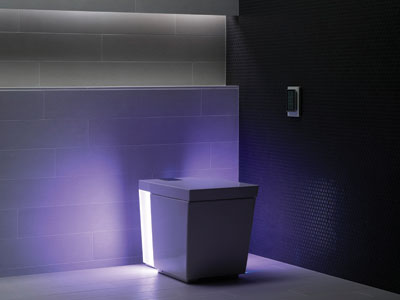American Pop: Toilets to Die For

Let’s talk toilets. This most familiar of household fixtures has long been the butt of cheap cracks, off-color jokes, and a million indignities both foul and (admit it) funny. Who hasn’t hurled a juvenile remark in the direction of the common can?
Well, enough already. The toilet is getting its moment. Manufacturers are bringing it out of the closet and offering to consumers an array of gee-whiz thrones that transform everyday bathroom visits into an experience that can practically be described as “transcendent.” (OK, maybe we can agree on “pretty darn fine.”) Given the economics, it’s a wonder it has taken so long to get here. Fact is, attending to our private business is a pretty big business–$8.5 billion a year divided among several companies that do battle in the global toilet wars.
Surprisingly, in the realm of high-tech toilets, America was, for a long time, well behind. Europe, Asia, and the Middle East were first to recognize the benefits of machines that use sophisticated engineering, science, and electronics to produce better all-around hygiene. And while the vast majority of American buyers still settle on basic commodes for their homes–the sweet spot is about $300–those who live in places like New York, Los Angeles, Miami, and Chicago are increasingly opting for the luxe marvels that feature, among other things, light-emitting bidet wands and self-opening lids.
It seems we have at long last arrived at a point in our cultural evolution where a quasi-robotic toilet is among the symbols of Big Dreams realized. No question but that you have got to be pretty flush to put one of these units in every bath: a lavishly outfitted model can go for as much as $6,000. It’s a huge deal, witnessing your first high-tech toilet being installed, its fittings glistening, its stainless steel bowl beckoning. Ever encounter someone who has just gotten one? (And you think sports fanatics are obnoxious?)
The bottom line is that washlets, as they’re commonly called by industry vets, do a superb job of keeping our anatomies (and themselves) sparkling clean. And, yeah, they burnish our egos too.
“At first, some people giggle” when they set eyes on these newfangled multifunction devices, says Brian Hedlund, senior product manager of toilets and bidets at Kohler, the top U.S. manufacturer in this segment. “Americans prefer toilet paper to bidets. It’s a difficult discussion to have with buyers. We do it as graciously as possible.”
For example, Hedlund might typically explain to a waffling shopper that his top-of-the-line Numi models can be had with an iPad-style remote controller that allows for preset ambient lighting, music (via FM radio or Wi-Fi), seat temperature, and bidet spray power. The Numi, like some other washlets at this price, automatically raises its lid when one approaches, relies on its internal sensors to activate the timing and intensity of its flushes, and uses electrolyzed water to clean itself at a predetermined hour every night. Embarrassed by the sounds you emit in the bathroom? Touch a button and masking noises will play. We’re not kidding; this is the real poop.
What’s next? At this very moment, scientists in California, Singapore, and the Netherlands are working on futuristic technologies to extract human waste from our homes. Several of these projects involve converting the waste into fuel. Perhaps that’s enough said.
For now, what matters most, says David Krakoff, president of sales for the Americas at Toto, a Japanese company that’s the international leader among toilet aficionados, is giving consumers a lovely pot that is delightful to use, flushes with the power of Niagara Falls, and improves our personal cleanliness. “One thing I’ve found,” Krakoff says, “is that consumers the world over are remarkably similar: We have the same bodily functions.”